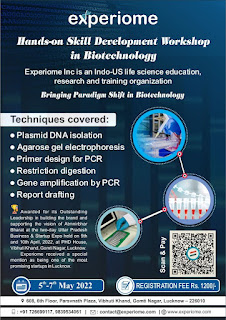Summer Internship for Biotechnology Students-Experiome Inc
Human genome Project
Renato Dulbecco was the first to propose sequencing the human genome in 1984 to understand about cancer. The National Academy of Sciences in the United States first proposed HGP in 1988, followed by the National Institutes of Health and the Department of Energy. In 2003, the project was publicly established and declared. This project is still the largest collaborative biological effort in the world. Australia, Brazil, Canada, France, Germany, Japan, and the United Kingdom are among the countries participating in the initiative. It was a big problem to map out genes despite spending a large sum of money on it, starting at around $3 billion.
In addition, the project experts
revealed that roughly 1.5 percent of DNA leads to the synthesis of proteins.
This raises the question of what the other 98.5 percent of DNA, known as
non-coding DNA, performs. Summer Internship for Biotechnology Students in Lucknow.
Over the last 20 years, scientists have
had unprecedented access to the molecular basis of how a cell functions, not
just in sickness but also in ordinary activities, thanks to the advancement of
gene-splicing techniques. Scientists have mapped out the genetic molecules, or
genes, that drive numerous life processes in ordinary microbes using these
techniques. Researchers have begun to construct maps of human chromosomes,
which contain many times the amount of genetic information as bacteria, thanks
to continued advancements in biotechnology. These maps have led to the
discovery of some significant genes, albeit in a primitive form.
Despite the fact that DNA sequencing
technology has evolved considerably in recent years, it is still too slow and
expensive to sequence even the small quantity of DNA found in a single human
chromosome. The HGP was crucial for initiating systems biology, with its concurrent
focus on high-throughput 'omics' data collection and the idea of 'big data' in
biology with its concentration on establishing the technology to enumerate a
components list. A complete parts list of the information elements of living
organisms is the starting point for systems biology (for example, genes, RNAs,
proteins and metabolites). Because, as the HGP has shown, the discipline is
experiencing an influx of skilled scientists using diverse techniques to a
range of challenges, the goals of systems biology are broad yet open-ended.
The integration of many different types
of biological information to create the 'network of networks' is a key feature
of systems biology, as we see it, recognising that networks operate at the
genomic, molecular, cellular, organ, and social network levels, and that these
are all seamlessly integrated in the individual organism. Models that are
predictive and actionable for specific types of organisms and individual
patients can be created by combining these data. These objectives necessitate
the development of new high-throughput omics technologies as well as
increasingly powerful analytical tools. Biotechnology Summer Training in Lucknow.

Comments
Post a Comment